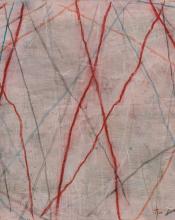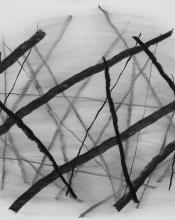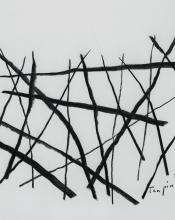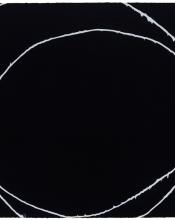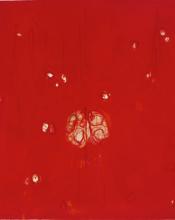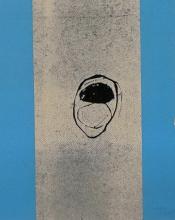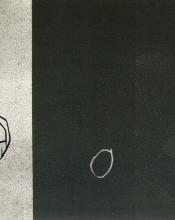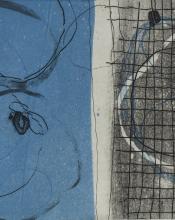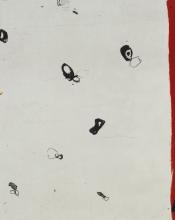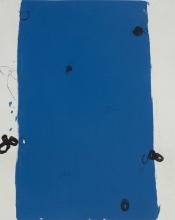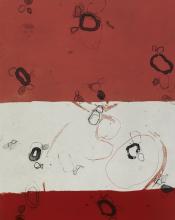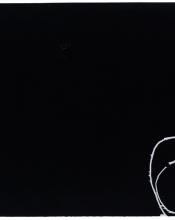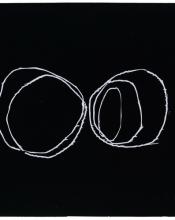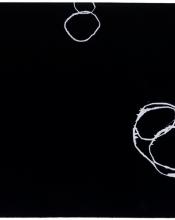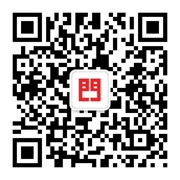Tan Ping
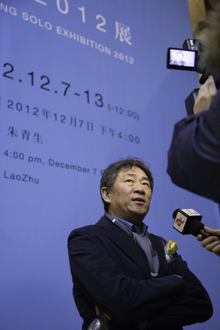
A Medium and Its External Features — Further Thoughts on Tan Ping’s Art: Yi Ying
Effects produced by the medium are decided by the medium’s properties and by the person who acts upon the medium. The return to medium is a historical process of modern art, proceeding from the separation of form and image, then to expression of pure form, and then to independence of the medium. Independence of medium saw its first breakthrough in traditional, two-dimensional art, and in contemporary art it has become an ordinary phenomenon, though people may not be sufficiently aware of it. The medium decides form, but at the same time the medium breaks down form. That is to say, if one comes to know the artwork by way of medium as language, one tends to exclude image and form, being more concerned with the effect produced in the medium through operation of a certain force. In general, shapes are created in etchings by lines; an imitative effect is produced by dense arrangements of lines. If the aim is not imitative, then free arrangements or combinations of lines can produce expressionist or abstract effects, conveying spiritual intensity. Tan Ping’s etchings are composed of just one line—a slender, refined line, not constituting an image or shape (form); it is a trace of the medium. Likewise, Tan Ping’s woodcuts only have relations of black with white. In the printing process, particles** exert a random effect which enlivens the black-and-white relations. For this kind of artwork, the key explanation points to limits of form or transcendence of form. There is a continuum from representation to abstraction, and then from abstraction to working with limits. Working with limits is not a matter of form, and it allows the medium to be expressed directly. The thought-progression in modernism has followed a course leading to post-modernism. Medium is presented by means of form, yet the meaning is not found in form; instead, it lies in the relation between person and medium; it lies in the process of a person acting upon the medium; it results from straightforward presentation of the medium’s properties. From image to abstraction, picture formats have a decisive function, and identical or similar formats can even be realized in different media. As for medium-based expression, which does not take the picture format as goal, there is no way to judge or predict its result. In fact, this is the advantage of medium. As we see in Tan Ping’s artworks, there is no way to analyze them according to pre-established picture formats. The exclusion of picture formats is something that Tan Ping has sought painstakingly. Tan Ping has a suite of pared-down paintings with only a single color on each of the large canvases, looking much like minimalist pieces, inasmuch as minimalism is also a product of medium. Tan Ping does not work with an original medium, but he fully exploits the irreproducibility and non-interchangeability of medium-based expression to create a form that is not like any other form of modern art. He repeatedly brushes pigment onto a large canvas; each application is an overlay of the previous application, giving a superficial impression of being a minimalist monochrome. However, each layer lets lower layers show through in a veiled manner. Such an artwork does not call for perusal of the visual surface; rather, the artwork is a process of overlay—a process becomes a record of spirit and will, expressed through the elemental quality of a medium.
In a certain sense, external features of the medium are also external features of the body: they are new objective facts shaped by unconscious actions of the body upon the medium. This is what we see in Tan Ping’s sketches. Tan Ping’s sketches are abstract; they are pared-down abstractions, but they are not encapsulations or simplifications based on objective form. They are traces of the body’s unconscious movements left on paper by a charcoal pencil. Modernist painting emphasizes the unconscious function of line—it is a historical, cultural, personal configuration built up in the unconscious mind, reflected by a line made non-purposively. Tan Ping’s line of course has these properties; the difference is that his line is independent. In modernism the line is usually used to create shapes or configurations. Tan Ping’s line does not express any subject—it is a result produced by direct action of his body upon the medium. Dense arrangements of lines or single divagations may resemble varying existential states of life. If this medium were to be exchanged for another, there would probably be no such effect. He fully utilizes both the obduracy and fluidity of the medium; he lets the medium do the talking—of course this is a mutual action of body and medium on each other. It seems likely that there is another possibility, namely, that Tan Ping possesses a special touch—both with hand and heart—that others cannot match. Thus his impulsive line comes out with better expressive quality than that of others. His line enters directly into his inner life and by virtue of the medium’s function, his line is more compelling. It is possible that both the former and latter statements are true.
Translated by Denis Mair
|
1960 |
Born in Chengde, Hebei Province |
|
1984 |
Graduated from the Printmaking Department, Central Academy of Fine Arts, (CAFA), Beijing |
|
1984 - 1989 |
Teaches in the Printmaking Department, CAFA, Beijing |
|
1989 - 1994 |
AkademischenAustauschdienste (DAAD) |
|
|
Master of Arts and Degree of 'Meisterschule', Free Art Department, |
|
|
Berlin Art University |
|
2002 - 2003 2003 - 2014 |
Deputy Chancellor, Professor, CAFA Vice President, CAFA |
|
2014 |
Vice President, Chinese National Academy of Arts |
|
Present: |
Professor, Supervisor of Doctoral Program of Chinese National Academy of Arts |
|
Solo Exhibitions
|
|
|
2019 |
Duet: A Tan Ping Retrospective, Yuz Museum Shanghai |
|
2017 |
TAN PING, Horsens Museum of Modern Art, Horsens, Denmark, |
|
|
……,Yuan Art Museum, Beijing |
|
|
The Certainty of Uncertainty, Leo Gallery, Hong Kong |
|
2015 |
Drawing - Art of Tan Ping, Ginkgo Space, Beijing |
|
|
Tan Ping: Follow My Line, ASU Art Museum, Tempe, USA |
|
2014 |
Follow My Line, PIFO Gallery, Beijing |
|
2013 |
Murmurs, Meilidao International Art Institution, Beijing |
|
2012 |
A Line, National Art Museum of China, Beijing |
|
2011 |
New Works, Yun Gallery, Beijing |
|
|
Prints, German Embassy, Beijing |
|
|
New Works, Yun Gallery, Beijing |
|
2010 |
Tan Ping at 50, Red Gate Gallery, Beijing |
|
2009 |
Tan Ping Art, Yun Gallery, Beijing |
|
2008 |
Tan Ping Art, Shenzhen Art Museum, Shenzhen |
|
|
Tan Ping Art, Today Art Museum, Beijing |
|
|
Tan Ping Art, Link & Keng Gallery, Beijing |
|
2007 |
Tan Ping Art, Studio Rouge Gallery, Shanghai |
|
2005 |
Tan Ping Art, National Art Gallery of China (NAGC) |
|
|
Tan Ping Art, Red Gate Gallery |
|
2004 |
New Woodcuts,Berlin |
|
2003 |
New Woodcuts,Red Gate Gallery |
|
2000 |
Black / White Time, Red Gate Gallery |
|
1999 |
Recent Etchings, Red Gate Gallery |
|
|
Black / White World - Etching, Asian Fine Arts Warehouse, Berlin |
|
1998 |
New Etchings, Red Gate Gallery |
|
1997 |
Recent Etchings, Red Gate Gallery |
|
1996 |
Recent Etchings, Red Gate Gallery |
|
1995 |
Introducing Tan Ping, Red Gate Gallery |
|
1994 |
Christof Weber Gallery, Berlin |
|
|
Beijing Contemporary Art Gallery |
|
1993 |
Moench Gallery |
|
1991 |
Moench Gallery, Berlin |
|
|
City Hall, Germering Gallery, Munich |
|
Group Exhibitions
|
|
|
2017 |
Chinese Spirit - 4th Chinese Oil Painting:Abstract - Non-fugurative Oil Painting of Chinese Contemporary, Today Art Museum, Beijing |
|
|
Abstract and Beyond - Research of Abstract Art in China, Minsheng Art Museum, Shanghai |
|
|
Red Gate on the Move, Red Gate Gallery |
|
2016 |
Beyond Every Mountain is Another Mountain – A Meeting of Contemporary Art from China and Switzerland, Helmhaus Museum, Zurich, Switzerland |
|
|
Oriental Abstraction VS Western Figuration: A Dialogue between Tan Ping and Luciano Castelli, SPSI Art Museum of Shanghai, Shanghai |
|
|
2016 Happy Chinese New Year, Fantastic Art China, Javits Convention Center, New York |
|
|
Research of Abstract Art in China, Today Art Museum, Beijing |
|
|
My Living Room – Red Gate 25th Anniversary, Red Gate Gallery |
|
2015 |
Nonfigurative, Shanghai 21st Century Minsheng Art Museum, Shanghai |
|
|
Calligraphic Time and Space – Abstract Art in China, Shanghai Contemporary Art Museum, Shanghai |
|
|
3rd Abstraction, Chambers Fine Art, Beijing |
|
|
Annual of Contemporary Art of China 2014, Beijing Mingsheng Art Museum, Beijing |
|
|
Follow My Line & Traffic Controls, Tan Ping and Liu Qinghe, Meilun Art Museum, Changsha |
|
|
Simple is Good, Red Gate Gallery, Beijing |
|
|
Oriental Abstraction VS Western Figuration: A Dialogue between Tan Ping and Luciano Castelli, National Art Museum of China, Beijing |
|
2014 |
VibrARTion Switzerland 2014, Forms of the Formless: Chinese Abstract Art, art-st-urban, Luzern, Switzerland |
|
|
In the Absence of Avant - Garde Reading, 798 Art Factory, Beijing |
|
2013 |
ChiFra Art, Champs Elysees, Paris |
|
2012 |
The Unseen Guangzhou Triennial, Guangdong Art Museum, Guangzhou |
|
|
Two Generations - 20 Years of Chinese Contemporary Art Australian Tour: City of Sydney Chinese New Year; Manning Regional Gallery; Damien Minton Gallery; University of Newcastle Gallery; Melbourne International Fine Arts (MiFA); Linton & Kay, Perth |
|
2011 |
Will of China, Museum of Contemporary Art, Beijing |
|
|
4th Chinese Abstract Art, PIFO Gallery, Beijing |
|
|
20 Years - Two Generations of Artists at Red Gate, island6 Art Center, |
|
|
Shanghai |
|
|
20 Years - Two Generations of Artists at Red Gate, Red Gate Gallery |
|
2010 |
National Art Museum, Beijing |
|
2009 |
China Form, Red Gate Gallery |
|
2008 |
Museum of Far Eastern Antiquities, Stockholm |
|
|
Alexander Ochs Gallery, Berlin |
Collections
USC Pacific Asia Museum; Ludwig Museum, Germany; Portland Art Museum, USA; National Art Gallery of China; Today Art Museum; Long Museum, Shanghai; Shenzhen Art Museum; Shanghai Art Museum; Qingdao Art Museum; ASU Art Museum; University of Sydney and numerous private collections
My works have a strong narrative component; I am reluctant to call them abstract art. Traditional abstract art has emphasised the meaning of dot-line paintings, colour, composition, and the value of negative space. Whenever I paint a painting, there is a strong narrative, but this narrative could be perceived by others as a feeling. Without this emotion, my works would indeed be spiritless.
Tan Ping

